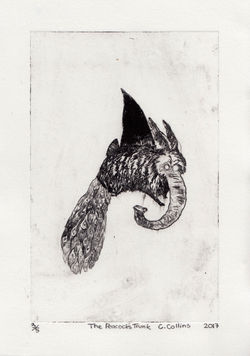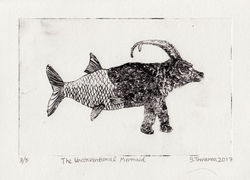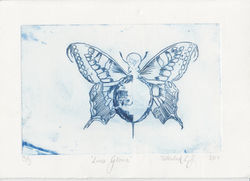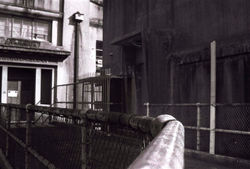
collaborative animation
Year 9 Visual Arts 2017 collaborated on creating this work using the text of Blythe Baird's slam poem 'When The Fat Girl Gets Skinny'. This unique form of animation is inspired by Richard Lewer's 'Never Shall Be Forgotten – A Mother’s Story' 2017 -
'chimera' - mythical creatures
In Term 1, we completed two series of etchings based on the study of mythical creatures and the Chimera. Whilst a mythical creature is derived from mythology or folklore, the chimera is a form of mythical creature comprised of two or more animals. Through the use of Adobe Illustrator and Photoshop we developed our own personal chimera; a strange and special creature that spoke to each of us - perhaps because of an unspoken power or even a strange beauty.
Through the development of drypoint techniques, using both traditional and contemporary materials, the class learnt how to create two small editions of prints. What fascinated me was the precision required when printmaking. We focussed on the smallest marks, suggesting the texture of animal skins through the use tiny engraved lines.
It was fascinating to learn about the special papers used in printmaking, to experience the tools unique to this ancient art form and how to create a multiple rather than a one-off artwork.
 |  |
|---|---|
 |  |
 |
The year 9 PDM class was very lucky to go on a PDM excursion to three different location using a minimum of three different camera. We first arrived at The Newington Armoury, where we used the Holga120N, and took pictures manually changing each of the setting on the camera, like aperture and focus. We were all in groups of two trying to fill a certain brief for each of the 6 photos we were allowed to take.
At the White Bay Power Station, we used a 35mm Film SLR camera, and walked along the pathway around the building to take our black and white pictures, which once we would return to our classroom, we would develop ourselves. Much like the first location, we also had to fit a brief, except this time we had more photos, so we had more chances to capture a shot that included such briefs as, nature or framing.
The last location we visited, The Paddington Reservoir, was very peaceful and relaxing setting for our final photos. There, we used digital camera, with no limit on how many photos we were allowed to take, but much harder settings to manually control, such as shutter speed, ISO, aperture, and exposure.
- Cade Collins
 |  |
|---|---|
 |  |
 |  |
 |  |
 |  |
 |  |
 |  |
 |  |
 |  |
 |  |
 |  |
 |  |
 |  |
 |  |
 |  |
 |  |
 |  |
 |  |
 |  |
 |  |
 |  |
 |  |
 |  |
in the field
vanitas
Students were inspired by 15th Century, Dutch oil painting style ‘vanitas’. Traditional vanitas represent morbid, decaying still life arrangements that touch on scenes of excess and decay. These works were made to remind viewers of the transience of life and the certainty of death. Students used moody, side lighting and off-camera flash to create dark and ominous still life scenes. They carefully constructed decaying symbolic objects, draped backgrounds and powerful monochromatic, colour scenes to portray traditional inspired works. Students extended this idea by creating a twist on the original vanitas to make comments on current world issues, including the fast food epidemic, consumerist society and the hold that technology has on youth.
 |  |
|---|---|
 |  |
 |  |
 |  |
soft machine
We started by looking at the ceramic work of Finnish artist Maija Liisa Vasenius and painter Elsworth Kelly. Through deconstructing and annotating their work, we were able to start our own creative process. We then explored the term ‘soft machine’ as a prompt for thinking about notions of combining mechanical parts and organic or natural shapes. By studying and mimicking some of the textual techniques of William S. Burroughs we were able to draw inspiration for our own designs. We received a page of text from a novel, this was then cut up and rearranged randomly into a poem:
The Boy
nothing again
can he come Mayor crossing his ginger hair
a boy with em.
army? guard me back to grandmothers’ How
434
Similarly, our initial drawings were cut up and rearranged into now abstracted designs. These ultimately guided our final design in stoneware and glaze. Throughout this process we were mentored by ceramic artist Holly MacDonald. She communicated with us via Skype and also used Google Docs to give us valuable feedback on our developing work.
Seeing all of our finished works together and exhibited on the wall was a great feeling of accomplishment.
- Claudia Burman
 |  |
|---|---|
 |  |
 |  |
 |  |
 |
